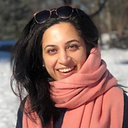A tattoo. Or three!!
Same, same, but different.
I could count on one hand, the number of days that were left for my wedding. It was a mid-Sunday afternoon when my sister called on facetime excitedly saying “Listen! This new tattoo artist is visiting from Nagaland. I have booked an appointment with him and I am going to get a tattoo this evening.”
“Oh wow. Sounds great”, I responded. Within the next 5 minutes, my younger sister and I thought “How about we get one too?”.
Twenty minutes later, we hopped into the car, and off we drove to a somewhat unknown and unassuming place for a tattoo studio in the bylanes of Bandra. Mom, of course, was flipping this entire time, “You girls are crazy! There’s a wedding in the family and you want to leave everything and go get a tattoo. What if you get infected? What if you don’t like it? What if…?”
Needless to say, I was oscillating between the “Just go for it” and the “Nah, sit this one out”. I decided to go with my gut which screamed “sibling love” in all the languages possible. The four of us sat in the waiting room, looking around at the tattoo photographs on the walls, Mom still trying to change our mind, calling dad to add weight to her cause, but eventually, happily, conceding.
All this while, we had no clue what we were even getting tattooed. Shouldn’t it be meaningful? Something you won’t regret? Not 20 minutes later, not 20 years later! I know each of us was flooded with these thoughts and the wait only added to the 101 questions endlessly entering our minds. And what a prized feeling that was. A shared experience, yet so personal.
Soon we met Mo Naga (Moranngam Khaling), a tattoo art and culture enthusiast, who revives Naga tattoos internationally — and, one of only three India-based artists featured in The World Atlas of Tattoo (Yale University Press). His tattoos are a mix of traditional and contemporary designs known for their sacred meanings and powerful symbolism. Pleasantly surprised, we learned that the values and belief systems that were represented by the Konyak tribe headhunters who bravely wore these tattoos were so progressive and were relevant even today. In its truest form, the tattooed legacy is what Mo is passing down through his art — where medieval meets modern — stories that were earlier passed along only verbally are now taking shape and form through tattoos. And, we were getting to be a part of this narrative.
The non-Naga clients are usually cultural tourists who respect and value local cultures. He says: “They don’t come to me to get tattoos just because they look good, or for fashion, or because they are unique. They come to me to learn about the Naga, their way of life, and our tattooing culture because very little has been written on the subject. What I do for them is combine elements of traditional Naga tattoo patterns with other art forms that tell a story of our ancestors as well as some aspect of their journey.”
-News 18
Thus began the process of Mo, his whiteboard, and three girls (plus mother) listening in on the revival of neo-Naga tattoos; eventually culminating into the (sometimes day long) consultation process where Mo gets to know us a bit more, gathers what tattoo recommendations to make and then gives us a selection from what he considers to be most symbolic to the Naga culture while holding to our personalities as well.
Mo Naga, who is in Manipur working on building a Tattoo Village where people would come to learn more about traditional Naga art, hopes that the travelers he tattoos today could lead to more interest in the tradition.
“When you have a Neo-Naga tattoo on your body, you become a cultural ambassador for my people: you will be telling a story about us to the world,” Mo Naga says. “You’ll be spreading the news of a dying tradition, and maybe you’ll get my people excited and interested in preserving and protecting it.”
So much about tattoo culture was unbeknownst to us. Tattoos especially on women’s faces were used as a distraction so that when men talked to them, they wouldn’t be able to look them directly in the eye and intimidate them. Mo’s theories and research on tattoo symbolism led him to design an arrow tattoo for us that signified strength and valor in headhunter tribes. This arrow was gifted to women as a rite of passage, as a symbol of the power they behold, or as a mark of their victory. We immediately fell in love with the idea of all three of us getting an arrow distinguished by unique fletching on each, along with our initials tattoed after it in Morse code.
One by one we lay on the bed, the whizzing of the tattoo machine, the ticking of the hand and poke tools, all becoming white noise gradually. In about an hour, we were done and excitedly showed off our tattoos. Fast forward, to my wedding day, and here we were, excitedly showing off our tattoos again.
(Almost!) Two years from that day, I am ecstatic when I look down at my ankle and narrate the story behind my tattoo to a friend while we both sip on hot toddies at a bar in NYC. Especially, as this winter looms on my head, I can’t wait to get on a jetplane and see family again. And who knows, maybe get inked once more? What say, mom?!
